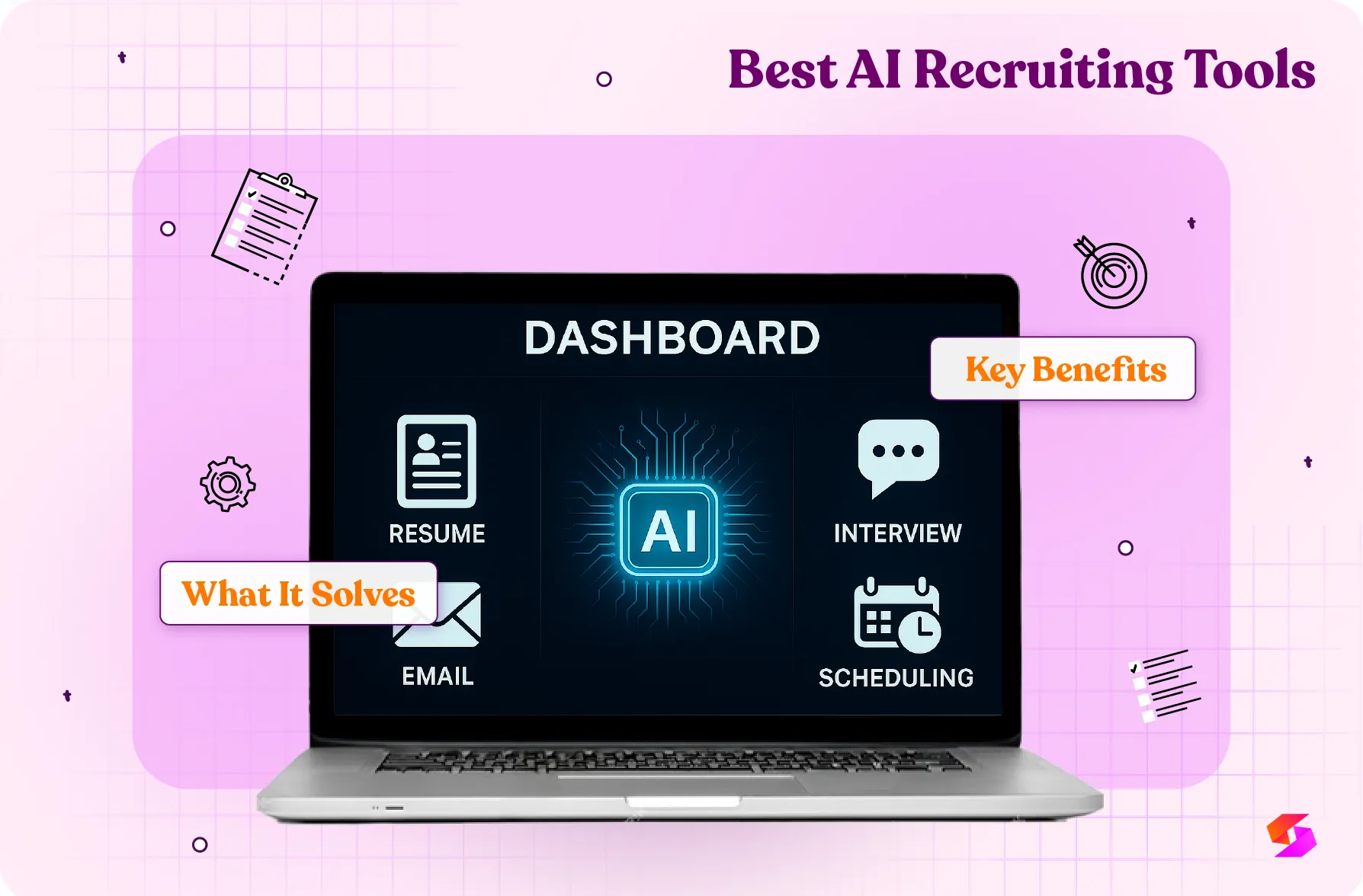We don’t need stats to tell you that a diverse workforce facilitates a positive work culture and contributes to overall increase in performance and productivity.
With a team built with varied ethnic diversity, cultural backgrounds and perspectives, it’s natural for a company to see more diverse ideas and unique solutions to problems.
Understanding this, companies are taking every measure to make their work environment one that embraces diversity, equity and inclusion (DE&I), starting with a DE&I recruitment strategy.
In addition to a business and growth perspective, DE&I is also about creating a level playing field for all talents out there.
It’s the ethical job of a recruiter to deliberately practice strategies to reduce bias in the hiring process and provide equal opportunity to suitable candidates for the job role.
Whether its unconscious bias hindering the hiring decisions or a clear prejudice against gender, ageism, sexual orientations etc., bias prevails.
Hence, recruiters and hiring managers must take a strong and powerful step in the direction of developing a DE&I recruitment strategy that prioritizes hiring the best fit candidate for a job role (nothing else).
In this article we explore some key tips that can help you in creating a DE&I recruitment strategy.
Before we do that, let’s explore some important aspects to what we call diversity, equity and Inclusion (DE&I).
What is DE&I?
DE&I (Diversity, Equity, and Inclusion) - although the three terms are independent of each other, they are closely related in the context of a workforce.
Diversity is related to the representation of people, their backgrounds, race, ethnicity, sexual orientation, and more.
A diverse workforce is often related to bringing more richness in terms of perspective and productivity to the table.
However, biases ranging from gender to age and culture have always impaired the recruiting process suppressing the underrepresented groups.
Equity ensures that all employers are treated fairly regardless of their background or individual circumstances.
Equity is more than Equality.
It goes deeper by recognizing and addressing systemic barriers that certain groups may face, guaranteeing everybody has equal access to opportunities and resources.
Inclusion involves a consistent effort to develop an environment where every team member or employee feels valued, respected, and empowered to contribute their unique talents and points of view.
It's about making an inclusive workplace where everyone belongs and ensuring that their voices are listened to and valued.
Studies show that when employees feel included, diverse talent is retained, and decision-making improves, driving business performance.
Diversity, Equity and Inclusion cannot be practiced independently.
In fact, a combination of the three is the best way companies can reduce biases and nurture growth.
While companies should implement it at the workplace, recruiters too have to incorporate it in their recruitment strategies.
Understanding Diversity Recruiting and the Importance of DE&I in Recruitment Strategy
Diversity recruiting is the process of creating a workplace with talents that are representative of the varied cultures and backgrounds present in the society we live in.
One can consider diversity as a blend of inherent traits, like race and gender, and acquired qualities, such as education and skills.
Inherent diversity, tied to natural characteristics, contrasts with acquired diversity, which grows with experience and education, enriching the workplace with different perspectives.
By prioritizing DE&I, recruiters can actively build diverse teams that represent marginalized groups, including those based on race, gender, ethnicity, sexual orientation, age, ability, and more.
An effective diversity recruiting would involve targeting outreach practices to underrepresented groups, creating inclusive job postings, implementing diverse interview panels, and providing training on unconscious bias.
In addition to a positive employer brand where diversity matters and inclusion shines, implementing DE&I also delivers growth driven benefits to business including:
- A broader team of highly skilled staff
- Diverse candidate pool
- Leadership with unique perspectives and problem solving capabilities.
With multifold advantages to the company, it’s natural for recruiters to put more effort in streamlining the recruitment process with a DE&I recruitment strategy.
10 Helpful Tips to Create a DE&I Recruitment Strategy
Just as you prepare a business plan, it’s important to assess your current work dynamics to analyze what it is that the company’s DE&I missing. Asking certain questions like
What are my diversity metrics? What is my current recruiting goal?
It’s necessary to have a fair understanding of what you want to achieve by implementing DE&I in your recruiting strategy.
For example - you might notice that your workforce lacks a balance of people from different backgrounds.
Here, your focus can be to look for suitable candidates from different ethnic backgrounds. However, the plan may be different if you had an all men team and want to include more women.
In other words, make sure you are clear where you want to take your first steps towards creating a DE&I recruitment strategy.
1. Make Your Communication More inclusive
The first step towards building a diverse candidate pool is assuring your initial communication is more inclusive.
Whether it’s job posts, paid ads or in-mail to passive candidates, your initial message should easily reach a broader candidate pool, especially Gen Z - the most diverse of all.
Go back, check your content and see if it’s tailored to reach a diverse group of candidates.
Check for over complicated language focused towards a specific experience or your graphics that appeals less to the modern job seeker.
2. Make it Easy for Underrepresented Groups to Reach You
Recruiting has always been a tedious process, there is no denying it.
So, naturally, recruiters have always preferred the most convenient methods to reach candidates.
Whether it’s relying on only a few school fairs or posting on similar job sites, repetitively using the same means can saturate the diversity in applications.
Better, change your recruiting strategy to encompass schools or universities where more underrepresented groups can be discovered.
Use a variety of job posting sites or recruitment channels that are representative of certain groups.
3. Promote Remote Work
Certain conditions like conducting physical interview processes only can restrict your ability to reach a large group of candidates.
This way you only discover local candidates, most from a similar background.
Hence, your hardest efforts too won’t allow you to find diversity in your candidate pool.
Achieve your diversity goals with a DE&I recruitment strategy that makes your hiring process more flexible.
Allow virtual interviews, spend more time with applicants from diverse backgrounds and geographic locations.
4. Emphasize on Equity
Make long term plans to assure equity is implemented across hierarchy in the office. Standardize promotions and salaries.
Focus on building a stronger team where low level interns are equally vocal with their ideas as the top level managers.
Further, when hiring on a large scale for internships, seek candidates from diverse backgrounds, train them and push them further in the process based on their performance.
This allows a company culture developed on trust and loyalty that nurtures exponential growth.
5. Create Affinity Groups
Build affinity groups within your current employee ecosystem.
Assure groups of diverse and inclusive employees are comfortable in sharing their concerns.
Take note of the improvements that can foster a vibrant community within your organization.
Also use the positives from the discussions to boast it on social media to build positive employer branding.
Further, these forums provide invaluable opportunities for candid discussions on crucial topics, fostering a culture where every voice is valued and heard.
These groups play a pivotal role in bolstering diversity, equity, and inclusion (DE&I) initiatives, offering a glimpse of belonging for potential hires and a platform for employees to connect over shared experiences.
6. Asses Your DE&I Metrics
Before you even begin to implement a DE&I recruitment strategy, look around and within your process.
Do you see a lack of diversity?
Is there a need for equity?
On the basis of your analysis create a list of DE&I metrics tailored to your organizational goals.
Don’t rely on your current or past recruitment strategies to work like magic.
Instead of making small changes, see if you can revamp your recruitment strategy from the ground up and make one that promotes diversity in the workplace, unconditionally.
7. Use Inclusive Imagery
Enhance your online presence by incorporating images showcasing a diverse range of models endorsing your products and services.
These visuals not only attract attention but also reflect your commitment to inclusivity, appealing to a wider audience.
Take a step further by revamping your career page to feature engaging DE&I (Diversity, Equity, and Inclusion) content.
Highlight initiatives, testimonials, and success stories that demonstrate your dedication to creating a diverse and welcoming workplace environment.
7. Use Referral Programs
Use your internal referral program to encourage your diverse employees to recommend candidates from their networks.
The strategy not only expands your talent pool but also promotes diversity and inclusion within your workforce.
Encourage employees to refer to qualified individuals who reflect the diverse backgrounds and perspectives you value.
By tapping into their networks, you gain access to a wider range of potential candidates.
A strong referral program strengthens employee engagement and fosters a sense of ownership and investment in the company's success.
Additionally, it streamlines the hiring process by connecting you with candidates who are pre-vetted by trusted insiders.
8. Practice Bling Hiring
Implement blind hiring techniques, which eliminate biases by concealing candidates' personal information during initial resume screenings.
Dive into your HR resource tools to explore how to integrate this feature effectively.
Tip: Skima AI resume software discovers top candidates for a job role based on hundreds of objective criterias to help you with an unbiased hiring process.
Blind hiring focuses on a candidate's qualifications and skills instead of gender, race, or background, ensuring fair evaluation.
By removing both conscious and unconscious bias, you give every applicant a fair shot at the job. This fosters diversity and inclusion within your workforce.
9. Plan and Implement DE&I Plans
Developing a DE&I recruitment strategy takes planning. But, at the end of the day, if the plans are not being implemented, you are not progressing in your DE&I goals.
So, be strategic and assure diversity plans are being incorporated into the work culture.
Whether its a short seminar on mental health for the young employees or picking an AI recruiting software that helps you reduce bias in hiring by screening and matching candidates objectively, budget, plan and get the approvals for implementation.
Finally, a DE&I recruitment strategy is a continuous process.
The only way you can achieve a truly diverse workforce is by taking feedback and making changes to your hiring process.
Head to our recruitment blog to learn more about Diversity, Equity and Inclusion at the workplace.



